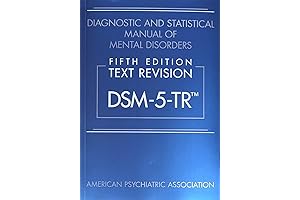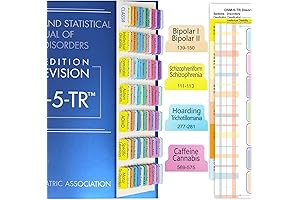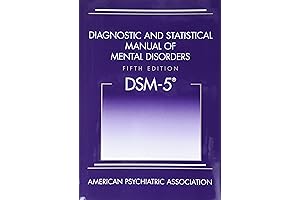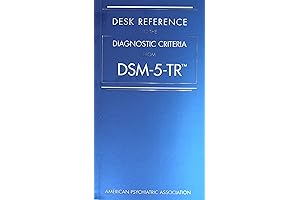· dsm 5 · 12 min read
Introducing the DSM-5, The Comprehensive Guide to Mental Disorders
Discover the DSM-5, a comprehensive guide to mental disorders. With its insightful insights, it's indispensable for healthcare professionals and students seeking to understand the complexities of mental health.
Prepare to delve into the DSM-5, the authoritative guide to mental disorders. This widely recognized resource provides mental health professionals and students with detailed descriptions, diagnostic criteria, and up-to-date information on over 150 mental disorders. Whether you're a seasoned practitioner or just starting your journey in the field, the DSM-5 is an indispensable tool.
Overview

PROS
- Comprehensive and up-to-date information on mental disorders
- Detailed diagnostic criteria and clinical descriptions
- Clear and concise writing style
CONS
- Can be overwhelming for non-clinicians
- Some users may find the diagnostic criteria too rigid
The Diagnostic and Statistical Manual of Mental Disorders, Fifth Edition (DSM-5) is the standard for the diagnosis and treatment of mental disorders. It is used by clinicians, researchers, and healthcare providers to accurately diagnose and treat mental health conditions.
The DSM-5 is a vast and complex manual, but it is an essential resource for anyone who works in the field of mental health. It provides comprehensive information on the symptoms, diagnosis, and treatment of mental disorders. The DSM-5 is also an important tool for research, as it helps to ensure that studies of mental disorders are using the same criteria for diagnosis.

PROS
- Comprehensive and up-to-date information on the diagnosis and classification of mental disorders.
- Clear and concise writing style makes it easy to understand and apply the information.
- Provides a common language for clinicians to communicate about mental health conditions.
- Essential resource for mental health professionals, researchers, and students.
CONS
- Can be expensive to purchase.
- Can be challenging to keep up with the latest changes.
The Diagnostic and Statistical Manual of Mental Disorders, Fifth Edition (DSM-5) is the essential guide to the diagnosis and classification of mental disorders. It provides a common language for clinicians to communicate about mental health conditions and ensures that everyone is using the same criteria for diagnosis. The DSM-5 is used by clinicians, researchers, and students to diagnose and treat mental disorders, and it is the standard for mental health insurance reimbursement.
The DSM-5 is divided into 20 chapters, each of which covers a different category of mental disorder. The chapters are organized by the most common symptoms of mental disorders, and each chapter provides detailed information on the diagnosis, treatment, and prognosis of the disorders in that category. The DSM-5 also includes a section on cultural considerations and a section on emerging measures and models. This comprehensive resource provides everything you need to know about the diagnosis and classification of mental disorders.

PROS
- Provides clear and comprehensive criteria for diagnosing mental disorders.
- Facilitates communication and collaboration among mental health professionals using a standardized framework.
- Enhances understanding of the causes and risk factors associated with mental health conditions.
CONS
- Can be complex to navigate and apply effectively.
- May not always accurately reflect the most up-to-date research and advancements in the field.
The DSM-5-TR (Diagnostic and Statistical Manual of Mental Disorders, Fifth Edition, Text Revision) is a valuable resource for mental health professionals seeking to understand and diagnose mental disorders. It offers a comprehensive set of criteria for accurately diagnosing a wide range of mental health conditions, facilitating effective communication and collaboration among professionals in the field.
The manual provides clear and concise descriptions of each disorder, outlining symptoms, diagnostic criteria, and differential diagnoses. This standardized framework ensures consistency in diagnosis, promoting accurate assessment and treatment planning. Additionally, the DSM-5-TR incorporates the latest research and updates in the field of mental health, ensuring that practitioners have access to the most current information.

PROS
- Provides clear and concise overviews of the DSM-5 diagnostic criteria.
- Features full-color anatomical illustrations and tables for easy understanding of complex concepts.
- Laminated for durability and portability, making it perfect for quick reference during clinical encounters.
CONS
- May not be comprehensive enough for in-depth study of the DSM-5.
- The laminated pages may become damaged with rough handling.
The DSM-5-TR Overview: a QuickStudy Laminated Reference Guide is an invaluable tool for mental health professionals and anyone interested in understanding the DSM-5 diagnostic criteria. This quick reference guide provides concise summaries of the DSM-5 criteria, making it easy to access the information you need during clinical encounters or while studying for exams.
The QuickStudy guide is organized by diagnostic category, with each category featuring full-color anatomical illustrations and tables to help you visualize and understand complex concepts. The laminated pages are durable and portable, making them perfect for taking with you wherever you go. Whether you're a seasoned clinician or a student just learning about the DSM-5, the DSM-5-TR Overview: a QuickStudy Laminated Reference Guide is an essential resource that will help you master the DSM-5 diagnostic criteria.

PROS
- Comprehensive and authoritative reference for mental health professionals
- Updated with the latest research and diagnostic criteria
- User-friendly format for easy navigation and reference
- Invaluable resource for students, practitioners, and researchers
CONS
- Can be overwhelming for non-professionals
- Some users may find the language technical
The Diagnostic and Statistical Manual of Mental Disorders, Fifth Edition, Text Revision (DSM-5-TR) is the latest edition of the American Psychiatric Association's (APA) diagnostic and statistical manual for mental disorders. It is the most comprehensive, up-to-date, and authoritative source of information on the diagnosis of mental disorders. The DSM-5-TR is used by clinicians, researchers, and policymakers to diagnose and classify mental disorders, and to develop treatment plans.
The DSM-5-TR is a valuable resource for anyone who is interested in mental health. It provides a wealth of information on the symptoms, diagnosis, and treatment of mental disorders. The DSM-5-TR is essential reading for clinicians, researchers, and policymakers. It is also a valuable resource for students, educators, and anyone who is interested in learning more about mental health.

PROS
- 94 pre-printed DSM-5-TR tabs for quick and accurate referencing
- 100 tabs in total, ensuring ample supply
- Precise alignment guide facilitates swift tab placement
- Disorders description sheet provides concise diagnostic criteria
- Improves organization, navigation, and time-saving
CONS
- Not suitable for other DSM editions
- May require additional customization for specific preferences
Elevate your DSM-5 navigation experience with our meticulously designed Upgraded Index Tabs. This comprehensive set of 94 pre-printed tabs, compatible with the latest DSM-5-TR 2022 edition, empowers you with lightning-fast referencing and unparalleled accuracy. With 100 tabs in total, you'll always have a ready supply for seamless organization.
Our ingenious alignment guide ensures effortless tab placement, eliminating any guesswork. The accompanying Disorders Description Sheet provides instant access to crucial diagnostic criteria, enhancing your understanding and streamlining your workflow. These tabs are meticulously crafted to seamlessly integrate with your DSM-5-TR, maximizing efficiency and optimizing your diagnostic journey.

PROS
- Comprehensive coverage of all mental disorders, providing clinicians with an up-to-date reference for diagnosis and treatment planning.
- Clear and concise format, making it accessible for clinicians, researchers, and students alike.
CONS
- The sheer volume of information can be overwhelming for some readers, potentially requiring multiple readings to fully grasp the concepts.
- The cost may limit access for some individuals or institutions.
The Diagnostic and Statistical Manual of Mental Disorders, Fifth Edition (DSM-5) is the gold standard reference guide for mental health professionals. It provides a comprehensive overview of all recognized mental disorders, including diagnostic criteria, symptom presentation, and treatment options. This latest edition reflects the most up-to-date research and advancements in the field of mental health, providing clinicians with an authoritative resource for accurate diagnosis and effective treatment planning.
The DSM-5 is meticulously organized, featuring a clear and concise format that enhances its usability. Each mental disorder is described in detail, outlining its essential features, prevalence, and diagnostic criteria. The manual also includes valuable information on differential diagnosis, comorbidity, and cultural considerations. This wealth of knowledge enables clinicians to make informed decisions regarding diagnosis and treatment, ensuring the best possible outcomes for their patients.

PROS
- Concise and comprehensive overview of the DSM-5 criteria
- User-friendly format with tables and diagrams
CONS
- Limited in-depth coverage of specific disorders
- May not be sufficient for professionals requiring comprehensive knowledge
The DSM-5 Overview is an invaluable resource for students, practitioners, and anyone seeking a concise yet comprehensive guide to the latest diagnostic criteria outlined in the DSM-5. Its user-friendly format, featuring concise tables and informative diagrams, ensures quick access to essential information.
As a concise overview, it focuses on providing a summary of the DSM-5 criteria rather than delving into the intricacies of each disorder. While this approach makes it ideal for quick reference or initial familiarization with the DSM-5, professionals requiring thorough knowledge may need to supplement it with additional resources.

PROS
- Comprehensive and up-to-date diagnostic criteria for mental disorders
- Clearly written and easy to use
- Indispensable for mental health professionals
CONS
- Expensive
- Can be overwhelming for non-professionals
The Diagnostic and Statistical Manual of Mental Disorders (DSM-5) is the fifth edition of the American Psychiatric Association's (APA) diagnostic and statistical manual for mental disorders. First published in 1952, the DSM is the most widely used diagnostic tool for mental health professionals in the United States and other countries. The DSM-5 was published in 2013 and represents a significant revision of the previous edition, the DSM-IV-TR.
The DSM-5 contains diagnostic criteria for over 150 mental disorders. These criteria are based on the latest research on the symptoms and causes of mental disorders. The DSM-5 also includes new sections on the diagnosis of mental disorders in children and adolescents, and on the cultural factors that can affect the diagnosis and treatment of mental disorders.

PROS
- Streamlined and user-friendly format enhances accessibility and comprehension.
- Precise explanations of diagnostic criteria provide a solid foundation for accurate assessments.
CONS
- Lacks in-depth discussions of differential diagnosis and comorbidity.
- May not be comprehensive enough for advanced clinical scenarios.
The Desk Reference to the Diagnostic Criteria from DSM-5-TR offers a concise and practical guide to the diagnostic criteria outlined in the DSM-5-TR. Its user-friendly format makes it an accessible resource for mental health professionals seeking a quick and reliable reference. The clear and precise explanations of each diagnostic criterion provide a solid foundation for accurate assessments.
While the Desk Reference excels in its user-friendliness, it falls short in providing in-depth discussions of differential diagnosis and comorbidity. For professionals seeking a more comprehensive understanding of these complex clinical presentations, additional resources may be necessary. Additionally, the Desk Reference's focus on diagnostic criteria alone may limit its utility for advanced clinical scenarios that require a broader understanding of the individual's presentation.
The DSM-5, published by the American Psychiatric Association, presents a comprehensive framework for diagnosing and classifying mental disorders. The fifth edition reflects advancements in our understanding of mental health, including updates to existing diagnoses, refinements to diagnostic criteria, and the introduction of new disorders. It serves as a valuable tool for mental health professionals, researchers, and students seeking to understand the latest developments and best practices in the field.
Frequently Asked Questions
What is the DSM-5?
The DSM-5 or Diagnostic and Statistical Manual of Mental Disorders, Fifth Edition, is a comprehensive reference guide for diagnosing and classifying mental disorders. Published by the American Psychiatric Association, it includes detailed descriptions and diagnostic criteria for over 150 mental disorders.
Who uses the DSM-5?
The DSM-5 is primarily used by mental health professionals, such as psychiatrists, psychologists, and social workers. It provides a common language and framework for diagnosing and discussing mental health conditions, facilitating communication and collaboration among professionals.
What are some of the key changes in the DSM-5?
The DSM-5 introduced several significant changes from previous editions, including updates to existing diagnoses, refinements to diagnostic criteria, and the addition of new disorders. It also included a dimensional approach to personality disorders, allowing for more nuanced assessment of personality traits.
How often is the DSM updated?
The DSM is typically updated every several years to reflect advancements in our understanding of mental health and to incorporate new research findings. The fifth edition (DSM-5) was published in 2013.
Is the DSM-5 considered the definitive authority on diagnosing mental disorders?
The DSM-5 is widely recognized as the most comprehensive and authoritative resource for diagnosing mental disorders. It is used by mental health professionals around the world and is considered the 'gold standard' for psychiatric diagnosis.













